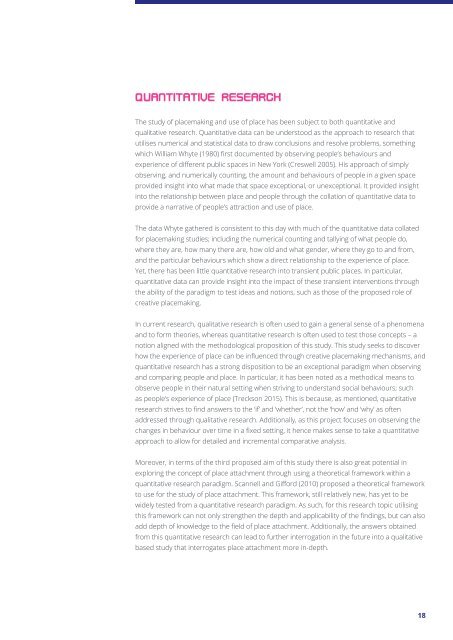Exploring the Role of 'Visual Catalysts' on Influencing People's Attraction and Use of Place
Undergraduate Thesis // Keegan Lovell // Bachelor of Landscape Architecure // UNSW 2016
Undergraduate Thesis // Keegan Lovell // Bachelor of Landscape Architecure // UNSW 2016
You also want an ePaper? Increase the reach of your titles
YUMPU automatically turns print PDFs into web optimized ePapers that Google loves.
QUANTITATIVE RESEARCH<br />
The study <str<strong>on</strong>g>of</str<strong>on</strong>g> placemaking <strong>and</strong> use <str<strong>on</strong>g>of</str<strong>on</strong>g> place has been subject to both quantitative <strong>and</strong><br />
qualitative research. Quantitative data can be understood as <str<strong>on</strong>g>the</str<strong>on</strong>g> approach to research that<br />
utilises numerical <strong>and</strong> statistical data to draw c<strong>on</strong>clusi<strong>on</strong>s <strong>and</strong> resolve problems, something<br />
which William Whyte (1980) first documented by observing people’s behaviours <strong>and</strong><br />
experience <str<strong>on</strong>g>of</str<strong>on</strong>g> different public spaces in New York (Creswell 2005). His approach <str<strong>on</strong>g>of</str<strong>on</strong>g> simply<br />
observing, <strong>and</strong> numerically counting, <str<strong>on</strong>g>the</str<strong>on</strong>g> amount <strong>and</strong> behaviours <str<strong>on</strong>g>of</str<strong>on</strong>g> people in a given space<br />
provided insight into what made that space excepti<strong>on</strong>al, or unexcepti<strong>on</strong>al. It provided insight<br />
into <str<strong>on</strong>g>the</str<strong>on</strong>g> relati<strong>on</strong>ship between place <strong>and</strong> people through <str<strong>on</strong>g>the</str<strong>on</strong>g> collati<strong>on</strong> <str<strong>on</strong>g>of</str<strong>on</strong>g> quantitative data to<br />
provide a narrative <str<strong>on</strong>g>of</str<strong>on</strong>g> people’s attracti<strong>on</strong> <strong>and</strong> use <str<strong>on</strong>g>of</str<strong>on</strong>g> place.<br />
The data Whyte ga<str<strong>on</strong>g>the</str<strong>on</strong>g>red is c<strong>on</strong>sistent to this day with much <str<strong>on</strong>g>of</str<strong>on</strong>g> <str<strong>on</strong>g>the</str<strong>on</strong>g> quantitative data collated<br />
for placemaking studies; including <str<strong>on</strong>g>the</str<strong>on</strong>g> numerical counting <strong>and</strong> tallying <str<strong>on</strong>g>of</str<strong>on</strong>g> what people do,<br />
where <str<strong>on</strong>g>the</str<strong>on</strong>g>y are, how many <str<strong>on</strong>g>the</str<strong>on</strong>g>re are, how old <strong>and</strong> what gender, where <str<strong>on</strong>g>the</str<strong>on</strong>g>y go to <strong>and</strong> from,<br />
<strong>and</strong> <str<strong>on</strong>g>the</str<strong>on</strong>g> particular behaviours which show a direct relati<strong>on</strong>ship to <str<strong>on</strong>g>the</str<strong>on</strong>g> experience <str<strong>on</strong>g>of</str<strong>on</strong>g> place.<br />
Yet, <str<strong>on</strong>g>the</str<strong>on</strong>g>re has been little quantitative research into transient public places. In particular,<br />
quantitative data can provide insight into <str<strong>on</strong>g>the</str<strong>on</strong>g> impact <str<strong>on</strong>g>of</str<strong>on</strong>g> <str<strong>on</strong>g>the</str<strong>on</strong>g>se transient interventi<strong>on</strong>s through<br />
<str<strong>on</strong>g>the</str<strong>on</strong>g> ability <str<strong>on</strong>g>of</str<strong>on</strong>g> <str<strong>on</strong>g>the</str<strong>on</strong>g> paradigm to test ideas <strong>and</strong> noti<strong>on</strong>s, such as those <str<strong>on</strong>g>of</str<strong>on</strong>g> <str<strong>on</strong>g>the</str<strong>on</strong>g> proposed role <str<strong>on</strong>g>of</str<strong>on</strong>g><br />
creative placemaking.<br />
In current research, qualitative research is <str<strong>on</strong>g>of</str<strong>on</strong>g>ten used to gain a general sense <str<strong>on</strong>g>of</str<strong>on</strong>g> a phenomena<br />
<strong>and</strong> to form <str<strong>on</strong>g>the</str<strong>on</strong>g>ories, whereas quantitative research is <str<strong>on</strong>g>of</str<strong>on</strong>g>ten used to test those c<strong>on</strong>cepts – a<br />
noti<strong>on</strong> aligned with <str<strong>on</strong>g>the</str<strong>on</strong>g> methodological propositi<strong>on</strong> <str<strong>on</strong>g>of</str<strong>on</strong>g> this study. This study seeks to discover<br />
how <str<strong>on</strong>g>the</str<strong>on</strong>g> experience <str<strong>on</strong>g>of</str<strong>on</strong>g> place can be influenced through creative placemaking mechanisms, <strong>and</strong><br />
quantitative research has a str<strong>on</strong>g dispositi<strong>on</strong> to be an excepti<strong>on</strong>al paradigm when observing<br />
<strong>and</strong> comparing people <strong>and</strong> place. In particular, it has been noted as a methodical means to<br />
observe people in <str<strong>on</strong>g>the</str<strong>on</strong>g>ir natural setting when striving to underst<strong>and</strong> social behaviours; such<br />
as people’s experience <str<strong>on</strong>g>of</str<strong>on</strong>g> place (Trecks<strong>on</strong> 2015). This is because, as menti<strong>on</strong>ed, quantitative<br />
research strives to find answers to <str<strong>on</strong>g>the</str<strong>on</strong>g> ‘if’ <strong>and</strong> ‘whe<str<strong>on</strong>g>the</str<strong>on</strong>g>r’, not <str<strong>on</strong>g>the</str<strong>on</strong>g> ‘how’ <strong>and</strong> ‘why’ as <str<strong>on</strong>g>of</str<strong>on</strong>g>ten<br />
addressed through qualitative research. Additi<strong>on</strong>ally, as this project focuses <strong>on</strong> observing <str<strong>on</strong>g>the</str<strong>on</strong>g><br />
changes in behaviour over time in a fixed setting, it hence makes sense to take a quantitative<br />
approach to allow for detailed <strong>and</strong> incremental comparative analysis.<br />
Moreover, in terms <str<strong>on</strong>g>of</str<strong>on</strong>g> <str<strong>on</strong>g>the</str<strong>on</strong>g> third proposed aim <str<strong>on</strong>g>of</str<strong>on</strong>g> this study <str<strong>on</strong>g>the</str<strong>on</strong>g>re is also great potential in<br />
exploring <str<strong>on</strong>g>the</str<strong>on</strong>g> c<strong>on</strong>cept <str<strong>on</strong>g>of</str<strong>on</strong>g> place attachment through using a <str<strong>on</strong>g>the</str<strong>on</strong>g>oretical framework within a<br />
quantitative research paradigm. Scannell <strong>and</strong> Gifford (2010) proposed a <str<strong>on</strong>g>the</str<strong>on</strong>g>oretical framework<br />
to use for <str<strong>on</strong>g>the</str<strong>on</strong>g> study <str<strong>on</strong>g>of</str<strong>on</strong>g> place attachment. This framework, still relatively new, has yet to be<br />
widely tested from a quantitative research paradigm. As such, for this research topic utilising<br />
this framework can not <strong>on</strong>ly streng<str<strong>on</strong>g>the</str<strong>on</strong>g>n <str<strong>on</strong>g>the</str<strong>on</strong>g> depth <strong>and</strong> applicability <str<strong>on</strong>g>of</str<strong>on</strong>g> <str<strong>on</strong>g>the</str<strong>on</strong>g> findings, but can also<br />
add depth <str<strong>on</strong>g>of</str<strong>on</strong>g> knowledge to <str<strong>on</strong>g>the</str<strong>on</strong>g> field <str<strong>on</strong>g>of</str<strong>on</strong>g> place attachment. Additi<strong>on</strong>ally, <str<strong>on</strong>g>the</str<strong>on</strong>g> answers obtained<br />
from this quantitative research can lead to fur<str<strong>on</strong>g>the</str<strong>on</strong>g>r interrogati<strong>on</strong> in <str<strong>on</strong>g>the</str<strong>on</strong>g> future into a qualitative<br />
based study that interrogates place attachment more in-depth.<br />
18


